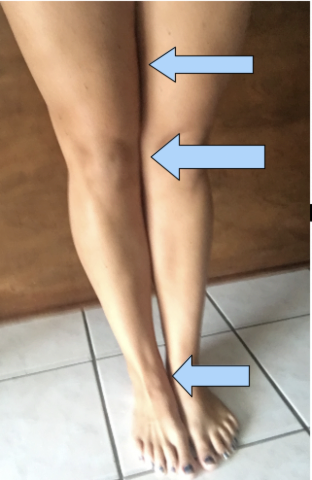What Do Flamingos & Breaststroke Kick Have In Common?
What Do Flamingos & Breaststroke Kick Have In Common?
Abbie Fish of Ritter Sports Performance shares a drill for improving breaststroke kick in swimming.

The breaststroke kick has an extensive history of being the hardest kick to teach age-group swimmers. Some kids are born with the ability to point their toes away from their bodies, and some need to be taught over and over again. The movement required in a breaststroke kick is not natural and may result in thousands of repetitions until the swimmer gets it right.
I'm sure many of you have heard or explained the breaststroke kick to something very similar to this: "You need to bend your knees and bring your heels back toward your buttocks. From there, grab onto the water and 'snap' your feet backward as you finish the kick."
But, how exactly do we do that?
What muscles need to fire in order to have a successful breaststroke kick?
Also, what does a flamingo have to do with anything?
In order to set up for a successful breaststroke kick, four main movements must occur:
1.) knees bend
2.) toes point away from the body
3.) tibia (lower leg) externally rotates
4.) hips abduct
Also, depending on how wide or narrow you like to teach your breaststroke kick, there may be more or less tibial rotation versus hip abduction.

If any one of these four movements shown above are not properly executed, a swimmer will miss the "catch" phase of his or her breaststroke kick. The reason I call this a "catch phase" is because the water that is on the inside side of the foot will be forcefully pushed backward as a swimmer extend his or her knees and straighten his or her legs to finish the breaststroke kick. This catch phase is important, as it is responsible for the majority of the propulsion created in a breaststroke kick.
Now that we understand the mechanics, how do we explain this in terms an age-grouper can understand?
Have your swimmers get out of the water and ask them to stand like a flamingo. Most will bend one of their knees and stand on one leg. At this point, you have a prime opportunity to teach them the proper mechanics of a breaststroke kick through a drill I call the "Flamingo Drill."
So let's restart -- your swimmers are all standing on one foot. From there, you should point out their leg with the bent knee -- the foot is relaxed and the toes are pointing toward the ground.

The reason this drill works is because it gives coaches a chance to change the position of a swimmer's toes from pointing toward the ground to pointing away from the body (to the side). On land, you can physically move their feet and change the angle of their toes. Also, you can determine how wide you want to teach the breaststroke kick by the distance between the knees as the swimmer goes through this drill.
The picture below shows the second part of the drill with the same original standing position, but this time the toes are angled outward. Also, the picture below shows very little knee movement.

Once you have the swimmer standing on one leg with his or her toes flexed and pointed away from the body -- the final step of this drill is to "snap" the legs back together. The "snap" is not finished until three (3) points of contact have occurred: (1) upper thighs, (2) knees, and (3) ankles. The snapping motion will be semi-circular.

Once the swimmer has completed the snap and the three points of contact are successfully displayed, he or she has completed this drill. I like to have my swimmers complete 2x10 repetitions on each leg before getting back into the pool.
Eventually with enough repetitions, your swimmers will gain an understanding of what it feels like to angle their toes away from their bodies and will be able to make the transition from doing it on land to water.
Stay tuned for next week's blog post where we discuss how to take this drill into the water and the benefits of the final position of the breaststroke stroke -- the horizontal, streamlined position.
Want a FREE stroke technique lesson from Abbie? -- HEAD HERE.
---
Abbie Fish has been in the competitive swimming realm for over 20 years. After capping off a successful career at University of Georgia, Abbie soon found herself back on the deck as a coach.
Currently, Abbie is a Technique Swim Coach at Ritter Sports Performance. She spends her time analyzing race videos and studying different style of stroke technique. If you'd like your stroke analyzed, or a swimmer of yours -- visit their website: www.rittersp.com/video for more information or email Abbie at abbie@rittersp.com
---
I'm sure many of you have heard or explained the breaststroke kick to something very similar to this: "You need to bend your knees and bring your heels back toward your buttocks. From there, grab onto the water and 'snap' your feet backward as you finish the kick."
But, how exactly do we do that?
What muscles need to fire in order to have a successful breaststroke kick?
Also, what does a flamingo have to do with anything?
In order to set up for a successful breaststroke kick, four main movements must occur:
1.) knees bend
2.) toes point away from the body
3.) tibia (lower leg) externally rotates
4.) hips abduct
Also, depending on how wide or narrow you like to teach your breaststroke kick, there may be more or less tibial rotation versus hip abduction.

If any one of these four movements shown above are not properly executed, a swimmer will miss the "catch" phase of his or her breaststroke kick. The reason I call this a "catch phase" is because the water that is on the inside side of the foot will be forcefully pushed backward as a swimmer extend his or her knees and straighten his or her legs to finish the breaststroke kick. This catch phase is important, as it is responsible for the majority of the propulsion created in a breaststroke kick.
Now that we understand the mechanics, how do we explain this in terms an age-grouper can understand?
Here is where the flamingo comes in...
Have your swimmers get out of the water and ask them to stand like a flamingo. Most will bend one of their knees and stand on one leg. At this point, you have a prime opportunity to teach them the proper mechanics of a breaststroke kick through a drill I call the "Flamingo Drill."
So let's restart -- your swimmers are all standing on one foot. From there, you should point out their leg with the bent knee -- the foot is relaxed and the toes are pointing toward the ground.

The reason this drill works is because it gives coaches a chance to change the position of a swimmer's toes from pointing toward the ground to pointing away from the body (to the side). On land, you can physically move their feet and change the angle of their toes. Also, you can determine how wide you want to teach the breaststroke kick by the distance between the knees as the swimmer goes through this drill.
The picture below shows the second part of the drill with the same original standing position, but this time the toes are angled outward. Also, the picture below shows very little knee movement.

Once you have the swimmer standing on one leg with his or her toes flexed and pointed away from the body -- the final step of this drill is to "snap" the legs back together. The "snap" is not finished until three (3) points of contact have occurred: (1) upper thighs, (2) knees, and (3) ankles. The snapping motion will be semi-circular.

Once the swimmer has completed the snap and the three points of contact are successfully displayed, he or she has completed this drill. I like to have my swimmers complete 2x10 repetitions on each leg before getting back into the pool.
Eventually with enough repetitions, your swimmers will gain an understanding of what it feels like to angle their toes away from their bodies and will be able to make the transition from doing it on land to water.
Stay tuned for next week's blog post where we discuss how to take this drill into the water and the benefits of the final position of the breaststroke stroke -- the horizontal, streamlined position.
Want a FREE stroke technique lesson from Abbie? -- HEAD HERE.
---
Abbie Fish has been in the competitive swimming realm for over 20 years. After capping off a successful career at University of Georgia, Abbie soon found herself back on the deck as a coach.
Currently, Abbie is a Technique Swim Coach at Ritter Sports Performance. She spends her time analyzing race videos and studying different style of stroke technique. If you'd like your stroke analyzed, or a swimmer of yours -- visit their website: www.rittersp.com/video for more information or email Abbie at abbie@rittersp.com
---